
9 minute read
A warm Guatemalan welcome - Part 3
Bishop Zielinski reflects on pastoral visit to San Lucas Toliman
This is the final installment of Bishop Zielinski’s reflection on his recent pastoral visit to Guatemala. Reflections I and II can be found in the last two editions of The Prairie Catholic, www.dnu.org/ communications.
Advertisement
Bishop Chad Zielinski’s pastoral visit in January to Guatemala came at the invitation from the Friends of San Lucas, a Minnesota-based non-profit that partners with and advocates for the San Lucas Toliman Mission by supporting its locally-led programs. Pictured above are the beautiful shores of Lake Atitlan in San Lucas, with inactive volcanoes bordering the waters. (Photos submitted)
by Bishop Chad Zielinski
Saturday, Jan. 28, 2023
There was a strong wind that blew that night. The roosters had decided to wake everyone in the neighborhood at 3:30 a.m. So, I decided to get up and start my morning with the roosters.
Visit to Café Juan Ana
My day began by taking a tour of Café Juan Ana, a program of the San Lucas Mission and the nonprofit Friends of San Lucas in Minnesota. The Mission’s former pastor, Fr. Greg Schaffer, founded this coffee program in 1992.
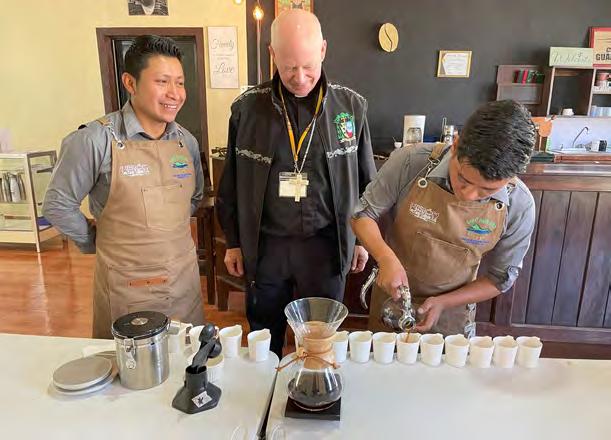
Fr. Greg recognized that the area around Lake Atitlan was a rich environment for producing coffee. However, at the time, the native Mayan coffee growers were being paid very poorly for their crops. Café Juan Ana’s direct trade model pays growers above-market rates for their coffee beans, resulting in a much better income for 100-plus families.
Annually, about 45,000 pounds of coffee are produced. The program’s director, Edy Morales Alvarez, briefed that the coffee is exceptionally high quality for three primary reasons: 1. it is grown at a high altitude of about 4,500 feet; 2. the volcanic soil, and 3. the unique climate around Lake Atitlan. Also, the coffee plants are grown in the shade around large trees, an eco-friendly process allowing larger trees to grow. This creates a more solid foundation for the earth, thus resulting in fewer mudslides during the rainy season.
Interesting fact: It takes 500 pounds of harvested coffee beans to make 65 pounds of roasted coffee.
Monseñor Gregorio Schaffer Hospital
During my time in San Lucas, I was welcomed to the Monseñor Gregorio Schaffer Hospital by a showering of firecrackers and large explosions called “bombas.” The staff was most friendly. A two-story building, the hospital provides general healthcare and several specialized healthcare. I visited the dental, optometry, surgery, and OB unit where babies are delivered. However, most children in the San Lucas region are born at home and delivered by a midwife. As a general rule, hospital births happen primarily during complicated pregnancies.
The hospital partners with various medical teams from the United States who travel to San Lucas to provide specialized medical care. The average medical visit costs the person 10 Quetzals, about $1.25. I was impressed with the number of people that were served. A lot of the medical equipment is outdated by U.S. standards but is functional. The hospital’s efforts in advancing medical outreach is significantly raising the quality of life for those in the local community.
The shores of Lake Atitlan
Following the hospital visit, Fr. Sam Perez (a priest of the Diocese of New Ulm whose homeland is San Lucas) and I ventured out for a 2.5-mile walk around part of Lake Atitlan, a large lake with water ranging from deep blue to green. Visible from the shores were some beautiful inactive volcanoes.
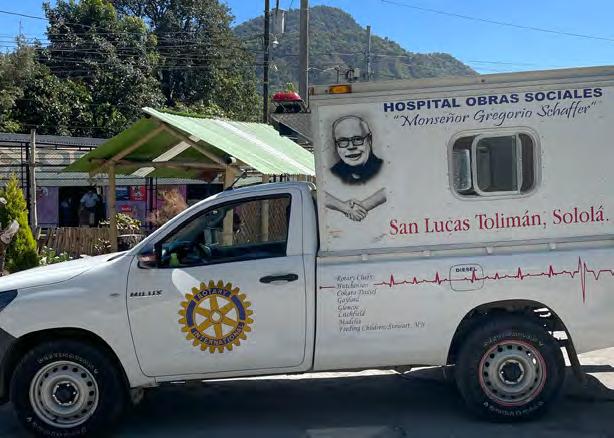
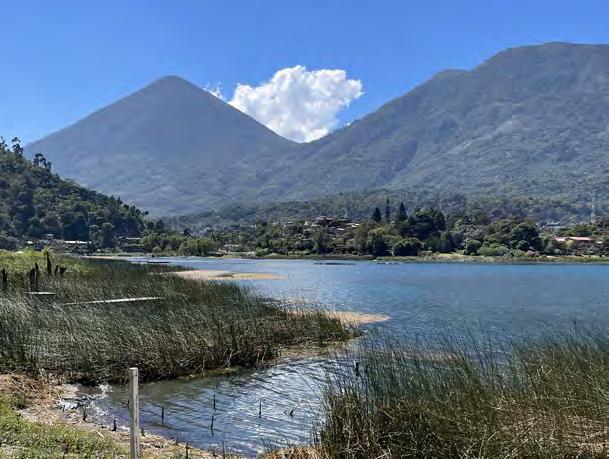
Visit to Fr. Sam’s Village and Mass at St. Michael the Archangel Parish Fr. Sam and I took a 20-minute ride to the village of San Gabriel, where he grew up. We made a quick stop at his family home so he could introduce me to his parents before we walked across the street to St. Michael the Archangel to celebrate a 4:30 p.m. Mass. What a lovely community. They have Mass about once a month due to a lack of priests in the area. Fr. Sam offers a regular Mass when he is home on vacation. I had the opportunity to greet the people following Mass. They were most grateful for my visit and for celebrating Mass with them. Most came to me to ask for a family blessing and take a photo.
Before darkness set in, we drove back to San Lucas Toliman. The road over the hill was in terrible condition with loads of large potholes. Fr. Sam told me that as a young teenager, he would walk on a trail through the woods up a very steep mountain to get to school. It was a 45-minute walk each way. I am amazed at the agility of the native people, young and old, carrying heavy loads of wood, sugar cane, and coffee beans. All were delicately balanced on the shoulders, back, or sometimes even on one’s head.
Another night of early to bed at 8:15 p.m.!
(Continued on page 7.)
While in Guatemala, Bishop Zielinski learned about the Café Juan Ana program that was founded in 1992 by Fr. Greg Schaffer in response to challenges faced by coffee growers in San Lucas Toliman. Café Juan Ana’s direct trade model pays growers abovemarket rates for their highest quality, 100% arabica coffee. The program helps support the health, education, and livelihood of Guatemalan growers and their families.
To purchase from Café Juan Ana visit https://juananacoffee.org/.
Healthcare at the Mission is provided by the Monseñor Gregorio Schaffer Hospital which was named after the Mission’s former pastor for 48 years, the late Fr. Greg Schaffer, a priest of the Diocese of New Ulm. Services include consultations, ultrasound, x-ray, maternity & delivery room, ER, dentistry, podiatry, pharmacy and an ambulance.
Sunday, Jan. 29, 2023
Rising at 4:30 a.m. with the roosters playing reveille seems to be the norm to begin my day in San Lucas. I followed it with another stupendous cup of hotly brewed coffee and prayed the liturgy of the hours to greet the new day.
That morning, Fr. Sam and I traveled 30 minutes to Santiago Atitlan, where Blessed Stanley Rother served and was martyred on July 28, 1981, at age 46. A priest of the Archdiocese of Oklahoma City, he is the first martyr from the United States and the first U.S.-born priest to be beatified. On the way, Fr. Sam pointed out an area of the road that wound up a perilous mountain. It was there where thousands of indigenous people were killed in the 1980s during a civil war between the militarist government forces and the guerrillas. The causes of the conflict and some of the current corruption and oppression of the indigenous peoples are multi-layered and highly complex. Fr. Sam mentioned that Fr. Greg had some near misses of being hurt or killed during the conflict but was able to keep his head low to accomplish his work.
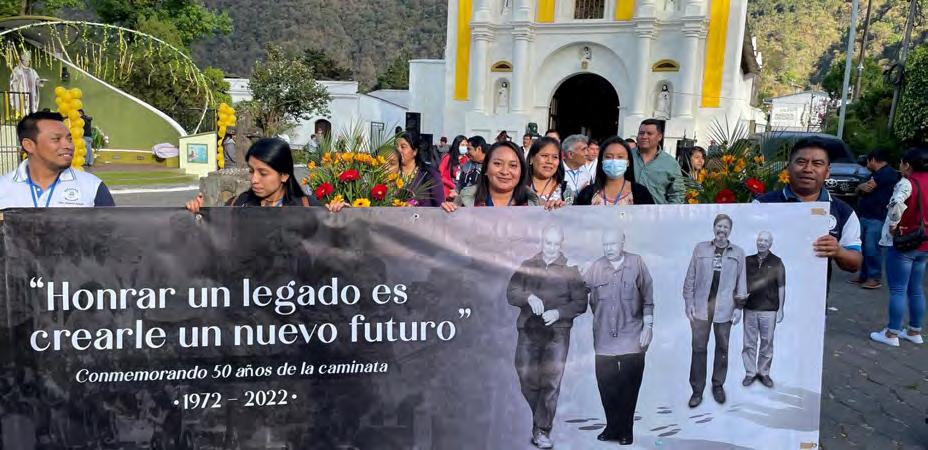
While in Santiago Atitlán, we made a stop at Santiago Apostal (St. James the Apostle) Church. We peeked into the church to find that Mass was being celebrated. The array of beautiful colors grabbed my attention. Similar to my visit to churches in Mexico, all the saints’ statues in the church were dressed in clothes. Fr. Sam told me that each village is recognized by its own color or collage/pattern of colors, and this would be a good opportunity for me to see the variety as the faithful departed the church. The women especially wore beautiful dresses with a full array of rainbow colors.
Once inside the church I noticed a memorial to Blessed Stanley Rother in the back. In front of the main altar was a vial of his blood. The experience was profoundly moving as I realized at that moment that a missionary priest from the United States fell in love with this culture and sacrificed his life to address the injustice that caused so much suffering and oppression.
I visited the room where Fr. Rother was murdered. It had been turned into a memorial chapel. Some of his personal clothing and belongings were preserved behind glass for visitors to view and a small box with a glass top permitted a person to view a hole/ indentation in the floor; the bullet impression of the last shot fired that killed Fr. Stanley. My visit to that room was moving beyond explanation. I looked at the photos of his body in state and saw a true hero who died for Christ and the love of the native people - deeply moving without words!
Following the church and memorial chapel visit, we wandered through the village as it was a huge market day, filled with various fruits, vegetables, and clothing that almost seemed like an artist intentionally placed each item in its proper place to create this well-balanced painting of colors and items.
I was taken by a few pieces of hand-sewn cloths that could be used as small tablecloths or table runners. I had more fun watching and listening to Fr. Sam engage in a bartering process with the women about the price. The funny thing was that both sides seemed to think they had won in the end! We returned to San Lucas Toliman with local artesian crafts to take back to the United States.
Ten-mile walk
The weekend celebration in honor of Fr. Greg carried into Sunday. As a symbol of sorts of Fr. Greg’s historic walk back in the early 1970s from the steps of the Minnesota State Capitol in St. Paul to San Lucas, groups representing 16 different villages, a number of the Mission’s staff along with visitors from the United States who came for the celebration, had already lined up at 5 a.m. that morning for a 10mile walk up a winding mountain road, to the St. Lucas Church in San Lucas. Fr. Sam and I joined the procession for about the last half mile.
I celebrated Mass with the pilgrims following the walk. The sanctuary, especially around the altar, was adorned with beautiful fresh-cut flowers that grow abundantly in the region. The same children’s choir from the Friday afternoon Mass was present. I was taken by the beauty of their singing.
Fr. Phil Schotzko, a priest of the Diocese of New Ulm who served in San Lucas for eight years, working beside Fr. Greg, gave the homily. Coincidentally, the Gospel that day was the beatitudes from Matthew 5. Fr. Phil did a magnificent job reflecting on the beatitudes as he saw them lived out in the lives of the local communities and the work of Fr. Greg. A most beautiful Mass that will be forever etched in my heart and soul.
A return family visit
Fr. Sam had driven his family’s Toyota Corolla over the mountain, and on our way back, we stopped for another visit with his family. Many of his siblings, nieces, and nephews had gathered to celebrate his nephew, Jeremias’ 5th birthday. Fr. Sam’s sister, Miriam, the mother of Jeremias, organized games for the 20-plus children. Some of the games were familiar to me. One of them was tying a balloon to one’s leg and trying to pop the balloon of an opponent until the one with the remaining balloon was honored as the winner, or, an all-time American favorite, musical chairs.
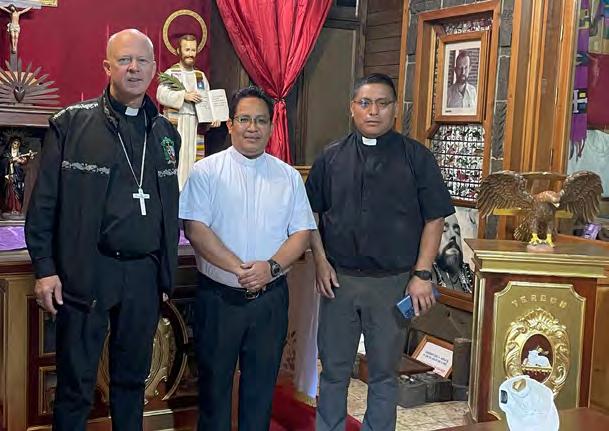
But, the big event of the birthday gathering was the breaking of the piñata. The excitement level of the children ramped up as the piñata was hung on a rope. Each was allowed three swings at the piñata with a long stick. As one can imagine, the older kids put some punch behind the swing, and the piñata burst open with candy flying in every direction.
The children scattered and screamed feverishly, gathering up the treats. I joined the adults on the sidelines, watching the joy of the children fill the room. The day’s celebration was complete with a birthday cake and a song in English and Spanish.
Fr. Sam’s family has operated a coffee plantation for years, and I was able to enjoy a cup of finely brewed coffee with a most unique flavor. I was gifted with a few bags for my return flight to Minnesota.
To end my day, Fr. Sam and I gathered for dinner back at the hotel with couples from New Ulm and other areas of Minnesota whom all serve on the Friends of San Lucas board. It was great to hear about some of the Mission’s history and Fr. Sam’s unique perspective on growing up in the local area.
Monday, Jan. 30, 2023
I departed San Lucas Toliman at 8:00 a.m. for a three-hour trip to the airport in Guatemala City. What an incredible experience in such a short amount of time. Overwhelmingly and graciously welcomed by all, I returned to Minnesota, a very blessed man with the sacred footprints of many of God’s good people in the San Lucas
by Fr. Mark Steffl, STL, JCL
The Code of Canon Law gives a general instruction that preparation must be given to those who desire to receive the sacraments:
Can. 843 §2. Pastors of souls and other members of the Christian faithful, according to their respective ecclesiastical function, have the duty to take care that those who seek the sacraments are prepared to receive them by proper evangelization and catechetical instruction, attentive to the norms issued by a competent authority.
The “pastors of souls” mentioned are most specifically diocesan bishops who are responsible for teaching and overseeing all that is done in their respective dioceses. Secondarily included would be the parish priests who share in this responsibility as co-workers







